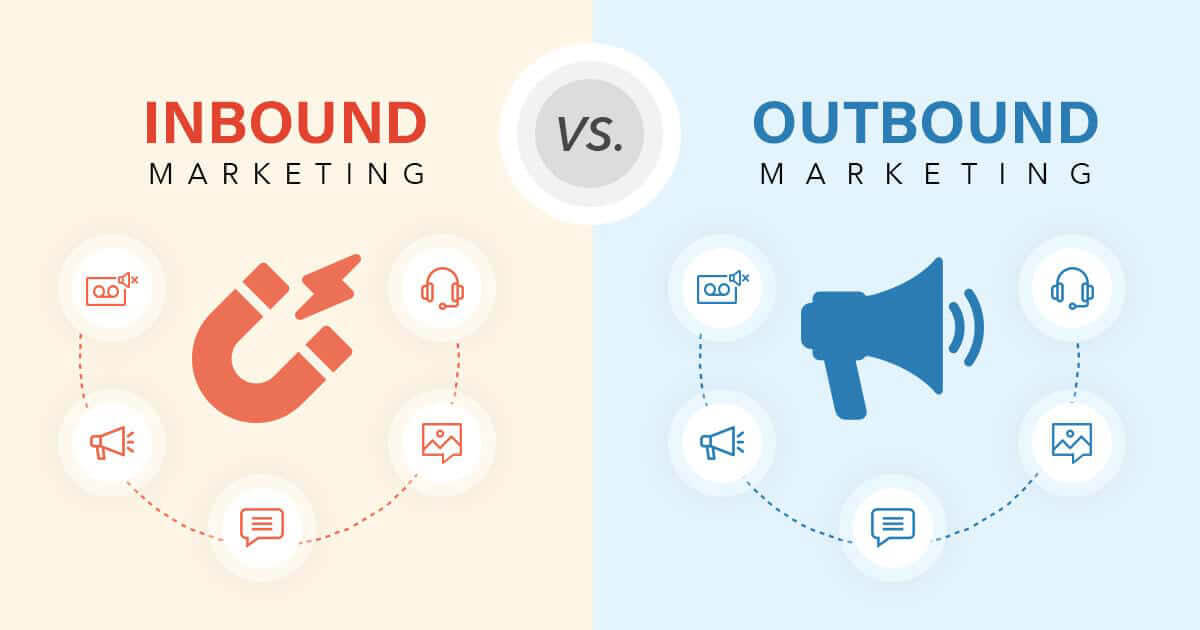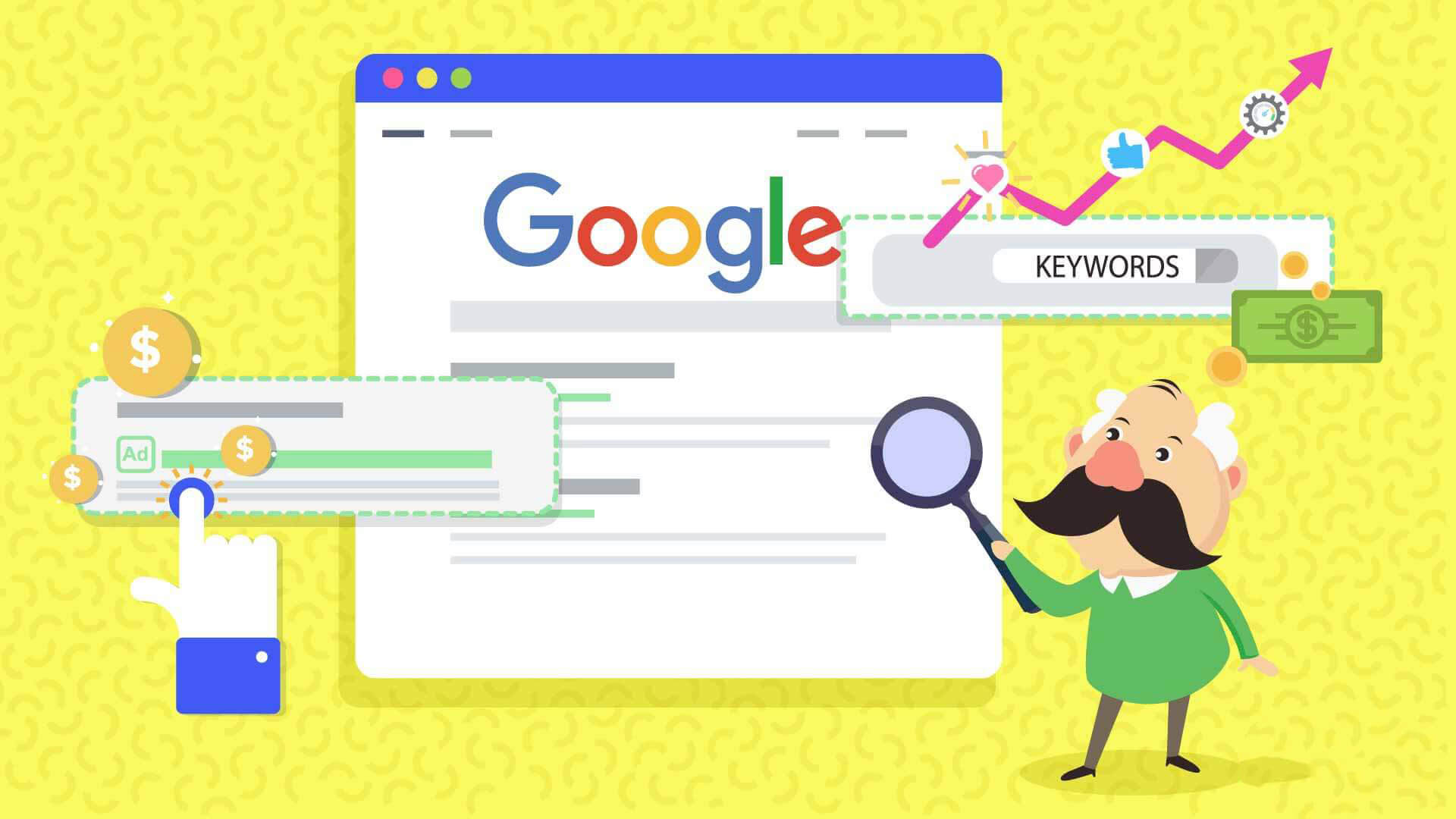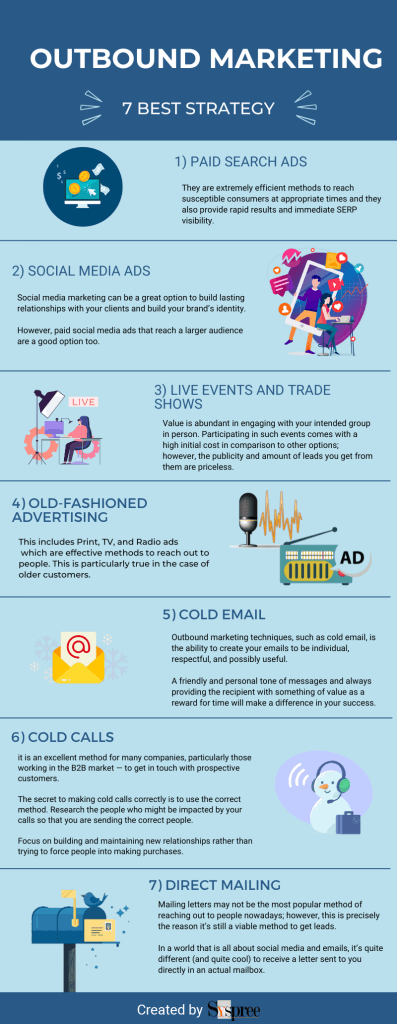Today, customers can access a wealth of information on the products they want to purchase. This is why it’s crucial to have a planned sales process, particularly when we’re talking about complicated sales.
Outbound Marketing strategies may be a wise investment if your business is looking to sign business deals with long-term buying cycles. To make this happen, you must be aware of the concept of Digital Marketing and how it works.
These are essential steps to enhance the effectiveness of your business. This guide by the best digital marketing company in Singapore will show all you need to know about Outbound Marketing, the advantages, and the best way to create a plan to achieve the most effective results for your business.
1. What exactly is Outbound Marketing?
Outbound Marketing is an active prospecting method. This strategy includes steps that permit the sales staff to meet your potential customers directly.
The process takes into account the customer’s journey and is done in a way that is objective, allowing your business to assess the results. By utilizing Outbound Marketing strategies, your sales team will effectively reach out to customers.
2. What are the pros and cons of an outbound Marketing Strategy?

What are the pros and cons of an outbound Marketing Strategy?
It is the right time to begin an Outbound Marketing strategy within an organization. It’s based on a few aspects of the selling process. It is possible to analyze the pros and cons to determine if this strategy suits your company. Find out more below!
Pros
A successful Outbound Marketing strategy is:
-
Predictable
-
Highly-customized
A complement and addition to the Inbound Marketing actions.
-
Predictable
If the business can structure its sales procedure, it is possible to track the conversion rate of each salesperson, the level of the funnel your clients are in, and any other pertinent details.
All this information will help you plan your business’s expansion. Requiring two salespersons to turn the leads of 100 into customers could increase the number of sales you make by hiring more salespeople.
-
Highly-customized
The comparative approach to Outbound Marketing allows for a higher degree of personalization. This is how you can establish a relationship with your customer based on their needs and expectations. This will increase the likelihood of closing sales.
In addition to inbound marketing techniques:
If a business has an Inbound Marketing strategy in place and operating, it can bring in more leads.
However, this method could not be effective without a strategy for the following steps.
An approach that can be used to supplement this strategy can be Outbound Marketing, influencing these leads to make a sale.
Cons
An Outbound Marketing strategy could yield great results; however, weighing the pros and negatives of such actions is important. The most important ones are:
- high-cost;
- one-way communication
- Adblocking.
-
High-cost
Outbound Marketing strategies typically require larger budgets, which can be a nightmare for many companies. The campaign requires a skilled team, specialized equipment, and effective management to be successful.
Additionally, the company needs to be aware of the possibility of raising costs during the campaign. This is why it’s vital to quantify how much ROI (ROI) is.
-
One-way communication
Digital Marketing strategies are designed to draw customers’ attention through indirect methods. Ultimately, customers are drawn to the company to purchase their solution.
In contrast, Outbound Marketing approaches the clients even if they did not request it.
This could cause them to feel more uncomfortable and less attracted to the purchase.
-
Adblocking
Another outcome of the uninvited strategy could be an act in the form of blocking the public.
Many people today know how to utilize tools like blocking advertising, telephone blockers for calls, and spam filters for email. They’re also excellent in unsubscribing to not requested email lists.
3. Outbound Marketing vs. Inbound Marketing

Inbound marketing vs. Outbound marketing
A few people have compared Outbound Marketing to another marketing method: Inbound Marketing. Therefore, they make them appear as if they were themselves opposites, but that’s not the case.
To put it in simple terms, they’re more compatible than opposites. To better understand how this happens, Let’s examine the distinctions between them.
Inbound Marketing
It is a method that convinces leads to join the business passively. The company accomplishes this by producing engaging content for its customers. If leads come into contact with the business, they already know what they are looking for and the item or service it offers.
Outbound Marketing
Outbound Marketing is an infuriating method of presenting a business to the general public. Often, customers aren’t aware of the issues they have to resolve. When a company contacts clients, it can help them identify their issues and provide solutions.
Although they are different strategies in their own right, when they are combined, they can help the business get more success.
4. How to Create a Profitable Outbound Marketing Strategy

How to create a profitable outbound marketing strategy
The experts offering digital marketing services Singapore says it is a structured method, Outbound Marketing has a variety of techniques and elements which we must combine to achieve the desired results. The following topics will discuss each of them. Read on to find out what you need to know!
-
Choose the right lead type and set objectives.
First, you must determine the types of leads and determine the amount of each one you require to reach your sales objectives. To do this, first, we need to start by making the buyer’s persona for every lead. We’ll define leads based on their acquisition channels:
Seeds: they are brought to the business via word-of-mouth. They don’t need an elaborate acquisition procedure, and they’re highly competent;
Nets: are leads brought to your business through Inbound Marketing. They’re fairly qualified.
Spears: are the Outbound Sales leads. They might or might not be qualified.
-
Get a qualified sales team.
Strategies for marketing outbound are quite common in SaaS -Software as a service — startup companies. They typically have an internal sales team with two kinds of sales representatives.
The companies realize that highly effective salespeople can be unproductive because they have to be divided between closing and prospecting processes. It can be addressed by having a professional on every stage.
We’ve identified the key differentiators between these two types of salespeople:
Hunters: prospect customers. They establish their first impression of the prospective and arrange an appointment;
Closing: display the product, draft the commercial proposal and the contract, then close the contract.
-
Be aware of the sales and prospect techniques.
Before starting your strategy, it is essential to implement some strategies to ensure success.
Cold letter and cold phone
The goal of a cold call is to reach out to a potential person who hasn’t made a purchase or made contact with your company. Cold calls are often mistaken for telemarketing calls, but there are some distinctions between the two.
When you make cold calls, you require skilled and well-prepared salespeople. Telemarketing isn’t always required. The KPIs and metrics can differ too. The most important thing to remember is that certain countries have strict regulations regarding calls to commercial numbers.
It’s important to note that, despite the negatives with regard to the target audience, cold calls are extremely effective when carefully planned and executed.
-
AIDA
Utilizing methods like AIDA cold calls is more likely to yield excellent results.
Find out the details of AIDA:
Awareness: You must catch customers’ attention within the first few seconds of the phone call or the subject of your email, demonstrating that you are aware of their issues.
Interests: the next step is to demonstrate how your business can address the consumer issue. The company should be able to demonstrate the benefits of the solution to make people interested in the product.
Finally, you have to help the consumer choose something they want to do, like booking an appointment or purchasing your product.
-
Utilize qualified patterns and frameworks
A lead-qualification matrix provides the best way to know how well-suited leads are to your company and the solutions you offer.
It’s not a good idea to have an entire list of leads who won’t purchase your product.
To figure out how hot an individual lead, you need to look at the profile and the maturity axis. Learn what each symbolizes:
Profile: it’s the principal characteristic of the lead, including the annual bill, employee’s volume as well as actuation market details that affect their adherence to your product
Maturity: refers to how educated leads are on their needs and how your product can assist them.
The digital marketing company Singapore believes, that with this method, you can eliminate leads who won’t purchase from you. This way, you’ll be able to assist and follow up with leads that require further education.
-
Create a lead follow-up, and make a forecast
To ensure the success of your Outbound Marketing strategy, it is essential to set up an ongoing monitoring and forecasting process. These techniques are essential for keeping potential buyers on your radar.
In this way, you will be able to spot and fix any issues during the selling process. Check that your team members follow up with the suggested frequency for monitoring customers.
Ask professionals to share their challenges as well as their successes and mistakes. It is essential to enhance your sales strategies.
-
Examine the results
It is crucial to track the outcomes of Outbound Marketing activities for various reasons, but most importantly, to justify the operation and make necessary adjustments.
It is important to establish the Key Performance Indicators (KPIs) to understand how the results are interpreted. The key Outbound Marketing KPIs are as follows:
The Lead Time (LT): It is the time it takes for a lead to move to the next phase in the funnel. It determines the duration of sales cycles.
Conversion Rate: The list of how many leads were converted into customers
Customer Acquisition Cost (CAC): It is the amount invested in acquiring new customers. This indicator defines the worth of each customer.
Lifetime Value (LTV): It is the amount that has been of money a customer spends within your business;
Churn Rate: How many customers opt to terminate their contracts before the time they are expected to do so?
7 Marketing Strategies for Outbound Marketing that are still effective today

7 Marketing Strategies for Outbound Marketing that are still effective today by the best digital marketing company in Singapore.
As per the digital marketing company, don’t believe every person who claims that outbound marketing is obsolete and no longer effective.
Not only are there a variety of strategies for outbound marketing that are still effective in the present, but certain strategies may even be better suited to certain individuals in your targeted audience depending on their age and where they reside, and many other aspects.
Here are some excellent examples.
-
Paid Search Ads
While search ads occupy an intriguing grey zone between outbound and inbound marketing, since they’ll only be displayed to users who have used a similar search query, they’ll have a sufficient reach to be considered outbound marketing.
They also remain extremely efficient methods to reach susceptible consumers at appropriate times. Standard SEO methods require taking a long-term approach and developing authority one step at a time, over months or weeks.
However, Google ads or any search ads provide rapid results and immediate SERP visibility. Make sure your advertisements, as well as your landing pages, are in line to get the best results.
-
Social Media Ads
Announcing that the average user spends many hours on social networks is an understatement.
The average use of social media these days is approximately 2.5 hours per day which means that advertising on social media is the chance to connect with customers during their leisure time.
Yes, social media marketing can be a great option to build lasting relationships with your clients and build your brand’s identity. However, paid social media ads that reach a larger audience are a good option too.
It’s also more efficient and produces better results than relying on organic outreach to get to your customers.
-
Live Events and Trade Shows
Many marketers of the digital age are prone to the error of thinking traditional outbound marketing methods, like trade exhibitions, conventions, trade shows, and other live events, aren’t important.
But value is abundant in engaging with your intended group in person. Participating in such events comes with a high initial cost in comparison to other options; however, the publicity and amount of leads you get from them are priceless.
Similar to any other kind of outbound marketing, be sure you’re getting the most out of your efforts by planning your budget well and setting specific goals.
-
Old-fashioned advertising (Print, TV, and Radio ads)
The traditional methods of advertising have evolved a lot since the advent of the internet and revolutionized the field of marketing. They’re nevertheless effective methods to reach out to people. This is particularly true in the case of older customers.
For instance, younger generations can spend hours on social networks daily; however, those 50 or older are more likely to watch TV. For example, Americans between 50-64 years old have about 5 hours of TV every day. Those 65 and older watch close to 6.5 hours.
-
Cold Email
If it seems as if the email has been around since the beginning of time, that’s because it’s.
However, it doesn’t show any evidence of being out of style at any time in the near future.
It’s still an amazing marketing opportunity for companies in the digital age, particularly in an age and age where we’re witnessing options such as newsletters being revived.
The most important thing to remember in the field of outbound marketing techniques, such as cold email, is the ability to create your emails to be individual, respectful, and possibly useful.
A friendly and personal tone of messages and always providing the recipient with something of value as a reward for time will make a difference in your success.
-
Cold Calls
Outbound marketing in many forms is viewed as aggressive, intrusive, and annoying, among other things, such as cold calling, which could be among them.
However, it is an excellent method for many companies, particularly those working in the B2B market — to get in touch with prospective customers.
The secret to making cold calls correctly is to use the correct method. Research the people who might be impacted by your calls so that you are sending the correct people.
Focus on building and maintaining new relationships rather than trying to force people into making purchases.
-
Direct Mailing
Mailing letters may not be the most popular method of reaching out to people nowadays; however, this is precisely the reason it’s still a viable method to get leads.
In a world that is all about social media and emails, it’s quite different (and quite cool) to receive a letter sent to you directly in an actual mailbox.
As with other types of outbound sales, the rate of success using direct mail will depend on the method you choose to use.
Always ensure that you’re targeting the right market based on variables such as geography, demographics, and purchasing records. Let your mailers stand out by being innovative and witty in your marketing campaigns addition.
Here we have created an infographic based on the information given above.

Conclusion:
In this article, Outbound Marketing is an element of the selling process. In addition to the distinctions in Outbound inbound and Inbound Marketing, both are complementary strategies.
These strategies are designed to improve the results of the business.
If your business involves large-budget companies with a lot of value-added, you should implement this approach using Inbound Marketing. In this way, you’ll be able to sustain growth. If you like this article, check out the previous blog 5 Top Strategies for Inbound Marketing.







